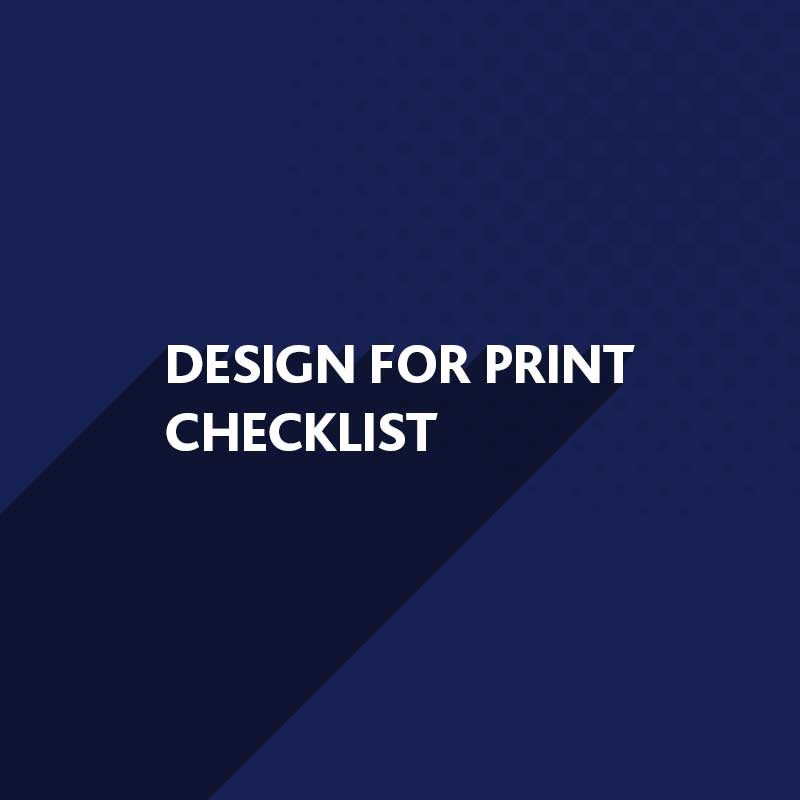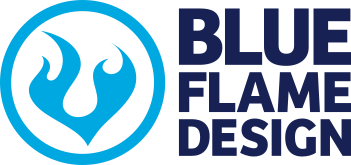
Design For Print Checklist
Use our Design for Print Checklist when you are designing a job that is to be printed there are certain things that need to be remembered and checked.
FOR A FOUR COLOUR PROCESS PRINT JOB
1. Make sure all images are 300dpi at actual size and saved as a tiff or eps
Note: if you blow a raster (Photoshop) image up in your layout programme (Quark/InDesign) you are in effect lowering the image resolution. Vector (Illustrator) files are resolution independent, which means they can be blown up without image quality deterioration.
2. Make sure images are set to CMYK
Note: CMYK stands for cyan, magenta, yellow and black, the colours the printer will use to create the print. Small dots of these colours will make all the different colours in the printed document eg. small dots of yellow and cyan will look like green.
3. Allow Bleed on a document – usually 3mm unless otherwise stated
Note: Bleed is an amount of image/colour etc that reaches out past the trim lines. This allows for print movement and slight inaccuracies, so if the guillotine moves slightly you won’t have a white edge for instance where there should have been blue.
4. Convert illustrator eps text to outlines
Note: Before you send a job to print if you are using an illustrator eps with text within it convert the text to outline. This prevents any font issues from the embedded font. make sure you save yourself a copy of the files without the text turned to outline in case you ever need to amend it.
5. Check your document only contains only the 4 colours CMYK.
Note: Make sure if you do have any spot colours that they are specified to split into 4 colour process.
6. Add a percentage of colour to large areas of solid black
Note: If you have a design that uses large areas of solid black it is a good idea to add a percentage of another of the process colours to it to give more density. For example, if I am doing a job with a large area of black I would perhaps create a new colour called special black with 100% black and 50% cyan (make sure it is set to split to process colours). This is often known as a shiner. You do have to be careful using this technique if you are using small text on the black, as any slip in the colours could mean that your white-out text, ends up cyan. If in doubt it’s best to take advice from your printer on this.
FOR A TWO COLOUR PRINT JOB
1. Make sure all images are 300dpi at actual size
2. Make sure images are set to duotones (or you can use monotones of one of the colours)
Note: If you are using duotones (images made up of two colours) make sure you have named your two colours the same in photoshop as you have in Quark or Indesign. Any slight differences will mean your document will output to more than one plate. For example, if you have chosen Pantone 144cvc as one of the colours in your duotone, but then choose Pantone 144cv (no c at the end) you are in fact creating an extra plate.
3. Allow Bleed on a document – usually 3mm unless otherwise stated
4. Convert illustrator eps text to outlines
Note: As mentioned in point 2 also make sure you have named colours the same throughout your files.
5. Check your document only contains the 2 colours you need and they are set up as spot colours
Note: (you won’t be able to get rid of the CMYK colours but in Quark can remove the default RGB blue-green and red)
USING CUTTER GUIDES
1. Create your cutter guide in illustrator and colour the stroke a SPOT colour, I usually name this Cutter. in illustrator specify in WINDOW – ATTRIBUTES overprint stroke (checkbox).
2. If you are pulling your cutter guide (as above) into quark – go into EDIT COLOURS – EDIT TRAP and set your cutter colour to overprint. This makes sure the cutter doesn’t interfere (knock-out) with any of the print work below it.
TRAPPING
In general, I leave quarks trapping to its defaults, except in the case of cutter guide as mentioned above or if I am working on a 2 colour job where I have text in one colour going over a pale tint of the other when I will specify the text to overprint. Otherwise, you get a spreading effect. If in doubt ask the printer to check the trapping for you.
MY PROCESS OF CHECKING DESIGN FOR PRINT
Whenever I am designing a document – unless I am just a concept stage I will ensure my images are all CMYK and 300 dpi and I have to include 3mm bleed as I go along. Once I get the go-ahead to send the artwork I will, however, do a final check. I use Quark so I will double check:
- I have included bleed wherever needed
- That all my colours are set to 4 colour process (for a 4 colour job) and I remove the default RGB Red Blue and Green colours in the Quark palette.
- Then I do a collect for output and open up all of my photoshop images to check they are CMYK and 300dpi and open up my illustrator images check them and convert any text to outlines
- If possible send a printout or PDF to the printer so the files can be checked against it. If you are using any spot colours make sure these are specified to the printer.
There are programs such as FlightCheck that will check your print is set up correctly – in terms of colour splits and images, but this is quite expensive.
Another good resource and one that I recommend fully is to visit the Pass4press website and download the relevant plug-in for your preferred application. Pass4press has set standards that are closely followed by the majority of today’s print companies and ripping your artwork through their PDF settings should be a must for anyone sending artwork to print.
